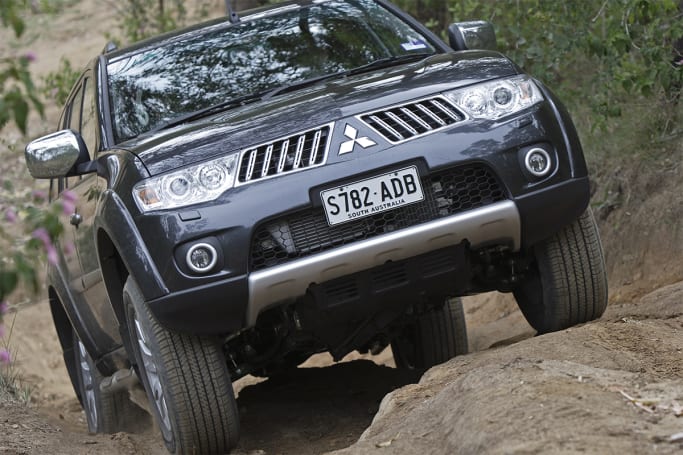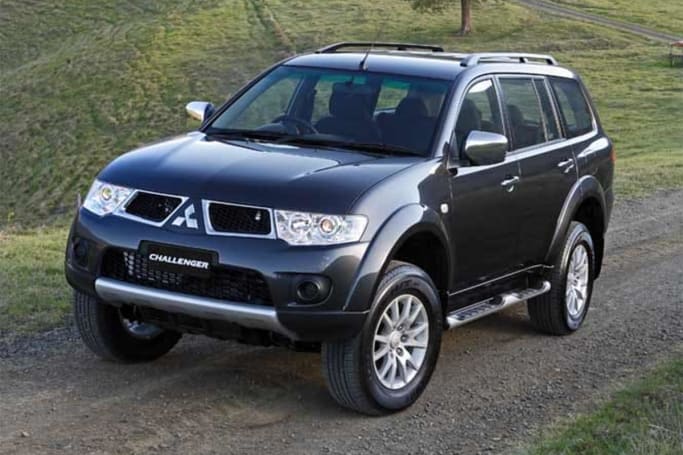
Used Mitsubishi Challenger review: 2009-2015
- Mitsubishi Challenger
- Mitsubishi Challenger 2010
- Mitsubishi Challenger 2011
- Mitsubishi Challenger 2012
- Mitsubishi Challenger 2013
- Mitsubishi Challenger 2014
- Mitsubishi Challenger 2015
- Mitsubishi Challenger 2009
- Mitsubishi Challenger Reviews
- Mitsubishi Reviews
- Mitsubishi SUV Range
- SUV
- Mitsubishi
- Used Car Reviews
- 7 seater

What we like
- Proper off-road ability
- Side-curtain air-bags on most examples
- Option of seven seats
What we don't
- Seats lack comfort
- Fuel tank too small for outback touring
- Some have been worked to death
What we like
- Proper off-road ability
- Side-curtain air-bags on most examples
- Option of seven seats
What we don't
- Seats lack comfort
- Fuel tank too small for outback touring
- Some have been worked to death
Mitsubishi’s Challenger was a bit ahead of its time in a way.
It took a pick-up and applied a four-door wagon body to create an off-road capable SUV, many years before the concept became as common as it is now (Fortuner, Everest, MU-X, and more).

First seen here in the late 1990s, there are still lots of Challengers getting around with 2000 or 2002 build dates, but those vehicles are getting a bit long in the tooth now.
Much better buying is from the last generation of Challengers, sold here before the Pajero Sport assumed the same role in the Mitsu line-up.
So aim for a 2009 to 2015 model and you’re buying a much better vehicle and don’t forget that the pre-July 2013 Challenger could be had with a seven-seater layout.
Models
Early models of this car were either LS or XLS variants with all-wheel drive, although a base-model was introduced in mid-2010 which was rear-drive only.
In mid 2013, Mitsubishi simplified the line-up, dropping the seven-seat option and rear-wheel drive variant in the process.

In a size comparison with the previous generation Challenger, the new car was bigger in every dimension and had more wheelbase, so it rode better.
The price you pay for a Challenger today will be based on its condition, and vehicles with lots of accessories can cost more, too.
Common additions range anywhere from floor mats to driving lights, a nudge bar or bull bar and aftermarket alloy rims and tyres.
But the serious off-road ability of the Challenger meant it was also often fitted with hardcore gear including underbody protection (bash plates) diff locks, a snorkel and aftermarket recovery points.
Cabin
The Challenger interior is quite roomy, although with the seven-seat option, there won’t be a lot of boot space with all the seats occupied.

That’s where the standard roof rails come into their own, allowing for a roof rack.
Some owners fitted a cargo barrier, but that’s not compatible with the seven-seat layout, and those that used their vehicles off-road often fitted drawers to the rear for easier camping.
Watch out for an interior that’s really knocked around as this could be evidence of a previous tradie owner who has worked the vehicle hard.
The biggest complaint from owners is that the standard seats are too firm and uncomfortable over longer journeys.
That’s especially true of the rear seats which are not only firm but feature a very upright backrest.
Engine
There was only one engine offered in this vehicle, a 2.5-litre turbo-diesel four-cylinder.

The specs are nothing out of the ordinary, but Mitsubishi tends to build long-lasting powerplants.
The motor used direct-injection and produced 131kW of power and, more importantly, 400Nm of torque (which dropped to 350Nm in the automatic transmission version).
Speaking of the gearbox, the auto was a five-speed, as was the manual, and the former is very good off-road, particularly in sandy conditions.
The 4X4 system was a part time set-up, so in most cases, you were only running in rear wheel drive.
Free wheeling hubs helped with fuel economy, too, and were a standard part of the specifications.
For off-road use, any Challenger will benefit form the addition of a dual battery system and a long range fuel tank (the standard tank had a capacity of just 70 litres, which, combined with the Challenger’s two-tonne-plus weight, was not enough for crossing deserts) but even in standard form, this was a serious off-roader.

And that alone places the Mitsubishi way ahead of most SUVs.
Aside from off-roading, the other activity you’ll often see a Challenger put to is towing.
A huge tow bar on a second-hand Challenger suggests this was a frequent activity, although the towing capacity is not as high as more modern vehicles at 2500kg with a braked trailer.
The Challenger engine uses a timing belt that must be changed every 100,000km.
Driving
While the part-time four-wheel drive and low ratio gearing give the Challenger great off-road capability, it’s not as good as modern stuff on-road where it soon belies its commercial-vehicle roots.

The steering is slow and pretty vague and the ride can be harsh and bouncy.
A previous owner who has fitted a lift-kit for more ground clearance off road will not have improved this aspect one bit.
That said, a Challenger with aftermarket alloy wheels and bigger tyres (with more sidewall) might actually ride a little better, but it’s a bit of a lottery until you actually try it in the real world.
Although based on the ladder chassis of the Triton workhorse, the Challenger got a more sophisticated three-link rear axle with coil springs, but it was still kind of crude compared with newer designs.
The body-on-frame construction, meanwhile, means the Mitsubishi will be at least as tough as the best of them although really big towed loads can place stresses on the suspension and driveline.
Straight line performance was not the Challenger’s long suit and 0-100km/h will take at least 10 seconds.

In everyday use, though, the turbo-diesel has enough performance although it’s not as smooth as some newer units and if you use all of the performance or tow anything remotely heavy, it’ll use plenty of fuel, too.
In fact, the official combined fuel consumption figure of 9.8 litres per 100km is quite a bit more than a modern off-roader which can easily have 10 or 15 per cent better fuel economy.
Safety
Getting a car with a separate ladder-chassis to score well in crash testing is a tough ask.
So, it’s no real surprise to learn that the Challenger’s safety rating was only four out of five stars in independent testing.
The best base-model Challenger is one built after October 2012 when front-side and side-curtain air-bags became standard.
But all LS and XLS Challengers had these features from launch.
The other big safety addition for a vehicle like this is a reversing camera.
Although they should be standard on high, long vehicles like these, the Challenger didn’t get a camera until the same October 2012 upgrade.
Even then, it was only available as part of an optional enhancement package which also brought rain-sensing wipers, automatic headlights, some interior and exterior trinkets and, believe it or not, a rear spoiler.
Any common issues?
Most owners have found the Challenger to be have good overall reliability, with possibly the most common Challenger problem being a build-up of soot and grot in the engine.

This accrues in the intake manifold, EGR valve and turbo-pipe and is most often seen when a vehicle has only been used for low-speed urban work.
A good run on the highway will often fix it, but if it’s bad enough, the gunge will have to be cleaned out by hand.
The other fault we see is one that affects a lot of modern diesel and amounts to fuel injectors with a very short life.
These are expensive and should be factored in when assessing service costs down the track.
Automatic gearbox problems seem rare, but the manual can be a bit noisy, particularly with the engine running, the car in neutral and the clutch engaged.
It’s called bearing rumble and it’s pretty typical of some Mitsubishi manuals. It’s also nothing to worry about.
But regardless of whether you have the auto gearbox or manual version, you might find that a Challenger tends to overheat on really hot days.
The trade reckons a batch of Challengers got dud head gaskets, perhaps combined with poor surface finishing on the cylinder block where the head mounts.
Mitsubishi actually changed its machining process in 2014 to get around this problem, so a later Challenger is potentially a better one.
But before you hit the panic button on that first hot day, the first thing to try is a radiator cap with a higher pressure rating.
That’s what Mitsubishi dealers were fitting and you’ll spot the improved cap by its `127kPa’ decal.
Make sure any early-build Challenger has been checked as per a recall for pre-2012 cars to look at front suspension arms that may have been poorly welded at the factory.
Other recalls dealt with power front seats that could cause fires, a dodgy front prop-shaft and incorrect child-restraint mounting points.
Read More: If anything crops up, you’ll probably find it on our Mitsubishi Challenger problems page.
Verdict
3/5 - Outdated orphan in some respects but works on a value for money basis.
Pricing
| Year | Price From | Price To |
|---|---|---|
| 2015 | $21,670 | $28,820 |
| 2014 | $20,020 | $26,840 |
| 2013 | $9,130 | $24,970 |
| 2012 | $8,250 | $21,340 |
| 2011 | $7,590 | $20,130 |
| 2010 | $10,560 | $19,250 |
| 2009 | $9,790 | $17,710 |
Pricing guides
Range and Specs
| Vehicle | Specs | Price* | |
|---|---|---|---|
| LS (5 Seat) (4x4) | 2.5L, Diesel, 5 SP MAN | $9,790 – 13,420 | 2009 Mitsubishi Challenger 2009 LS (5 Seat) (4x4) Pricing and Specs |
| LS (7 Seat) (4x4) | 2.5L, Diesel, 5 SP AUTO | $12,430 – 16,610 | 2009 Mitsubishi Challenger 2009 LS (7 Seat) (4x4) Pricing and Specs |
| XLS (5 Seat) (4x4) | 2.5L, Diesel, 5 SP AUTO | $12,870 – 17,160 | 2009 Mitsubishi Challenger 2009 XLS (5 Seat) (4x4) Pricing and Specs |
| XLS (7 Seat) (4x4) | 2.5L, Diesel, 5 SP AUTO | $13,420 – 17,710 | 2009 Mitsubishi Challenger 2009 XLS (7 Seat) (4x4) Pricing and Specs |
Other cars to consider
$12,911
Lowest price, based on 3 car listings in the last 6 months










